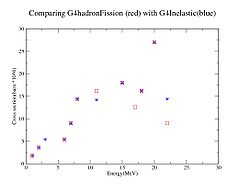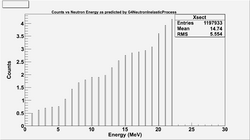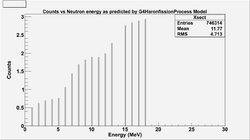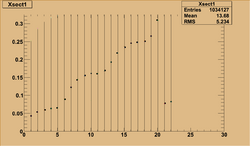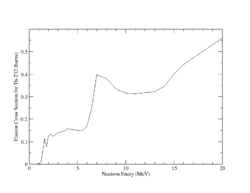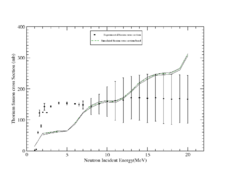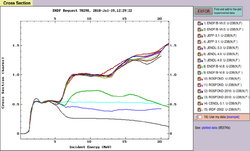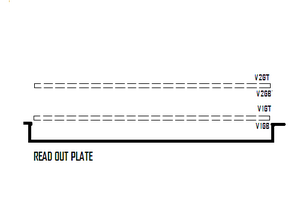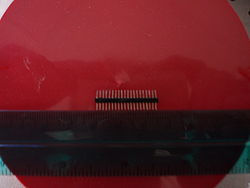2010
01/05/10
- Simulation of the mass distribution spectra for Thorium-232 for 7.5 MeV
(1st figure is the full spectrum but the 2nd one for a>1)
Three kinds of events tracked :
*********************************************************************************************************
* G4Track Information: Particle = neutron, Track ID = 1, Parent ID = 0
*********************************************************************************************************
Step# X Y Z KineE dEStep StepLeng TrakLeng Volume Process
0 0 fm 0 fm -80 cm 7.5 MeV 0 eV 0 fm 0 fm World initStep
1 0 fm 0 fm -5 mm 7.5 MeV 0 eV 79.5 cm 79.5 cm World Transportation
2 0 fm 0 fm -3.06 mm 0 eV 0 eV 1.94 mm 79.7 cm Target NeutronInelastic
:----- List of 2ndaries - #SpawnInStep= 3(Rest= 0,Along= 0,Post= 3), #SpawnTotal= 3 ---------------
: 0 fm 0 fm -3.06 mm 578 keV 1
: 0 fm 0 fm -3.06 mm 291 keV 1
: 0 fm 0 fm -3.06 mm 35.5 keV 231
:----------------------------------------------------------------- EndOf2ndaries Info ---------------
*********************************************************************************************************
* G4Track Information: Particle = Th231[14330.9], Track ID = 4, Parent ID = 1
*********************************************************************************************************
Step# X Y Z KineE dEStep StepLeng TrakLeng Volume Process
0 0 fm 0 fm -3.06 mm 35.5 keV 0 eV 0 fm 0 fm Target initStep
1 251 um 2.7 mm 5 mm 35.5 keV 0 eV 8.5 mm 8.5 mm Target Transportation
2 2.43 mm 2.61 cm 7.5 cm 35.5 keV 0 eV 7.39 cm 8.24 cm World Transportation
3 3.17 mm 3.41 cm 9.87 cm 35.5 keV 0 eV 2.5 cm 10.7 cm Tracker StepLimiter
4 3.91 mm 4.2 cm 12.2 cm 35.5 keV 0 eV 2.5 cm 13.2 cm Tracker StepLimiter
5 4.65 mm 4.99 cm 14.6 cm 35.5 keV 0 eV 2.5 cm 15.7 cm Tracker StepLimiter
6 5.39 mm 5.79 cm 17 cm 35.5 keV 0 eV 2.5 cm 18.2 cm Tracker StepLimiter
7 6.12 mm 6.58 cm 19.3 cm 35.5 keV 0 eV 2.5 cm 20.7 cm Tracker StepLimiter
8 6.86 mm 7.37 cm 21.7 cm 35.5 keV 0 eV 2.5 cm 23.2 cm Tracker StepLimiter
9 6.98 mm 7.5 cm 22.1 cm 35.5 keV 0 eV 3.94 mm 23.6 cm Tracker Transportation
10 2.5 cm 26.9 cm 80 cm 35.5 keV 0 eV 61.1 cm 84.7 cm OutOfWorld Transportation
*********************************************************************************************************
* G4Track Information: Particle = neutron, Track ID = 3, Parent ID = 1
*********************************************************************************************************
Step# X Y Z KineE dEStep StepLeng TrakLeng Volume Process
0 0 fm 0 fm -3.06 mm 291 keV 0 eV 0 fm 0 fm Target initStep
1 -624 um -1.4 mm -5 mm 291 keV 0 eV 2.47 mm 2.47 mm Target Transportation
2 -25.6 cm -57.4 cm -80 cm 291 keV 0 eV 1.01 m 1.02 m OutOfWorld Transportation
*********************************************************************************************************
* G4Track Information: Particle = neutron, Track ID = 2, Parent ID = 1
*********************************************************************************************************
Step# X Y Z KineE dEStep StepLeng TrakLeng Volume Process
0 0 fm 0 fm -3.06 mm 578 keV 0 eV 0 fm 0 fm Target initStep
1 434 um -5 mm 811 um 578 keV 0 eV 6.34 mm 6.34 mm Target Transportation
2 6.94 cm -80 cm 61.6 cm 578 keV 0 eV 1.01 m 1.01 m OutOfWorld Transportation
- and
*********************************************************************************************************
* G4Track Information: Particle = neutron, Track ID = 1, Parent ID = 0
*********************************************************************************************************
Step# X Y Z KineE dEStep StepLeng TrakLeng Volume Process
0 0 fm 0 fm -80 cm 7.5 MeV 0 eV 0 fm 0 fm World initStep
1 0 fm 0 fm -5 mm 7.5 MeV 0 eV 79.5 cm 79.5 cm World Transportation
2 0 fm 0 fm -2.2 mm 0 eV 0 eV 2.8 mm 79.8 cm Target NeutronInelastic
:----- List of 2ndaries - #SpawnInStep= 2(Rest= 0,Along= 0,Post= 2), #SpawnTotal= 2 ---------------
: 0 fm 0 fm -2.2 mm 1.91 MeV 1
: 0 fm 0 fm -2.2 mm 19.7 keV 232
:----------------------------------------------------------------- EndOf2ndaries Info ---------------
*********************************************************************************************************
* G4Track Information: Particle = Th232[5594.3], Track ID = 3, Parent ID = 1
*********************************************************************************************************
Step# X Y Z KineE dEStep StepLeng TrakLeng Volume Process
0 0 fm 0 fm -2.2 mm 19.7 keV 0 eV 0 fm 0 fm Target initStep
1 -560 um -4.06 mm 5 mm 19.7 keV 0 eV 8.29 mm 8.29 mm Target Transportation
2 -6 mm -4.35 cm 7.5 cm 19.7 keV 0 eV 8.06 cm 8.88 cm World Transportation
3 -7.69 mm -5.58 cm 9.67 cm 19.7 keV 0 eV 2.5 cm 11.4 cm Tracker StepLimiter
4 -9.37 mm -6.81 cm 11.8 cm 19.7 keV 0 eV 2.5 cm 13.9 cm Tracker StepLimiter
5 -1.03 cm -7.5 cm 13.1 cm 19.7 keV 0 eV 1.42 cm 15.3 cm Tracker Transportation
6 -6.23 cm -45.2 cm 80 cm 19.7 keV 0 eV 77 cm 92.3 cm OutOfWorld Transportation
*********************************************************************************************************
* G4Track Information: Particle = neutron, Track ID = 2, Parent ID = 1
*********************************************************************************************************
Step# X Y Z KineE dEStep StepLeng TrakLeng Volume Process
0 0 fm 0 fm -2.2 mm 1.91 MeV 0 eV 0 fm 0 fm Target initStep
1 689 um 5 mm 2.07 mm 1.91 MeV 0 eV 6.61 mm 6.61 mm Target Transportation
2 11 cm 80 cm 68.1 cm 1.91 MeV 0 eV 1.05 m 1.06 m OutOfWorld Transportation
- In addition to the fission event
*********************************************************************************************************
* G4Track Information: Particle = neutron, Track ID = 1, Parent ID = 0
*********************************************************************************************************
Step# X Y Z KineE dEStep StepLeng TrakLeng Volume Process
0 0 fm 0 fm -80 cm 7.5 MeV 0 eV 0 fm 0 fm World initStep
1 0 fm 0 fm -5 mm 7.5 MeV 0 eV 79.5 cm 79.5 cm World Transportation
2 0 fm 0 fm 1.2 mm 0 eV 0 eV 6.2 mm 80.1 cm Target NeutronInelastic
:----- List of 2ndaries - #SpawnInStep= 7(Rest= 0,Along= 0,Post= 7), #SpawnTotal= 7 ---------------
: 0 fm 0 fm 1.2 mm 138 keV 1
: 0 fm 0 fm 1.2 mm 2.37 MeV 1
: 0 fm 0 fm 1.2 mm 78.3 MeV 123
: 0 fm 0 fm 1.2 mm 1.83 MeV 1
: 0 fm 0 fm 1.2 mm 4.17 MeV 1
: 0 fm 0 fm 1.2 mm 653 keV 1
: 0 fm 0 fm 1.2 mm 89.1 MeV 105
:----------------------------------------------------------------- EndOf2ndaries Info ---------------
*********************************************************************************************************
* G4Track Information: Particle = Mo105[14330.9], Track ID = 8, Parent ID = 1
*********************************************************************************************************
Step# X Y Z KineE dEStep StepLeng TrakLeng Volume Process
0 0 fm 0 fm 1.2 mm 89.1 MeV 0 eV 0 fm 0 fm Target initStep
1 5 mm 442 um 1.9 mm 89.1 MeV 0 eV 5.07 mm 5.07 mm Target Transportation
2 80 cm 7.07 cm 11.4 cm 89.1 MeV 0 eV 80.6 cm 81.1 cm OutOfWorld Transportation
*********************************************************************************************************
* G4Track Information: Particle = neutron, Track ID = 7, Parent ID = 1
*********************************************************************************************************
Step# X Y Z KineE dEStep StepLeng TrakLeng Volume Process
0 0 fm 0 fm 1.2 mm 653 keV 0 eV 0 fm 0 fm Target initStep
1 5 mm 1.85 mm 719 um 653 keV 0 eV 5.35 mm 5.35 mm Target Transportation
2 80 cm 29.7 cm -7.55 cm 653 keV 0 eV 85.1 cm 85.7 cm OutOfWorld Transportation
*********************************************************************************************************
* G4Track Information: Particle = neutron, Track ID = 6, Parent ID = 1
*********************************************************************************************************
Step# X Y Z KineE dEStep StepLeng TrakLeng Volume Process
0 0 fm 0 fm 1.2 mm 4.17 MeV 0 eV 0 fm 0 fm Target initStep
1 4.44 mm 1.75 mm -5 mm 4.17 MeV 0 eV 7.82 mm 7.82 mm Target Transportation
2 57.4 cm 22.6 cm -80 cm 4.17 MeV 0 eV 1 m 1.01 m OutOfWorld Transportation
*********************************************************************************************************
* G4Track Information: Particle = neutron, Track ID = 5, Parent ID = 1
*********************************************************************************************************
Step# X Y Z KineE dEStep StepLeng TrakLeng Volume Process
0 0 fm 0 fm 1.2 mm 1.83 MeV 0 eV 0 fm 0 fm Target initStep
1 2.07 mm 3.07 mm 5 mm 1.83 MeV 0 eV 5.31 mm 5.31 mm Target Transportation
2 4.01 cm 5.96 cm 7.5 cm 1.83 MeV 0 eV 9.77 cm 10.3 cm World Transportation
3 5.05 cm 7.5 cm 9.41 cm 1.83 MeV 0 eV 2.66 cm 13 cm Tracker Transportation
4 43.4 cm 64.5 cm 80 cm 1.83 MeV 0 eV 98.5 cm 1.11 m OutOfWorld Transportation
*********************************************************************************************************
* G4Track Information: Particle = Cd123[14330.9], Track ID = 4, Parent ID = 1
*********************************************************************************************************
Step# X Y Z KineE dEStep StepLeng TrakLeng Volume Process
0 0 fm 0 fm 1.2 mm 78.3 MeV 0 eV 0 fm 0 fm Target initStep
1 -5 mm -1.83 mm 485 um 78.3 MeV 0 eV 5.37 mm 5.37 mm Target Transportation
2 -80 cm -29.3 cm -11.3 cm 78.3 MeV 0 eV 85.4 cm 86 cm OutOfWorld Transportation
*********************************************************************************************************
* G4Track Information: Particle = neutron, Track ID = 3, Parent ID = 1
*********************************************************************************************************
Step# X Y Z KineE dEStep StepLeng TrakLeng Volume Process
0 0 fm 0 fm 1.2 mm 2.37 MeV 0 eV 0 fm 0 fm Target initStep
1 -5 mm 328 um 1.75 mm 2.37 MeV 0 eV 5.04 mm 5.04 mm Target Transportation
2 -80 cm 5.25 cm 8.89 cm 2.37 MeV 0 eV 80.1 cm 80.7 cm OutOfWorld Transportation
*********************************************************************************************************
* G4Track Information: Particle = neutron, Track ID = 2, Parent ID = 1
*********************************************************************************************************
Step# X Y Z KineE dEStep StepLeng TrakLeng Volume Process
0 0 fm 0 fm 1.2 mm 138 keV 0 eV 0 fm 0 fm Target initStep
1 5 mm 2.66 mm 3.68 mm 138 keV 0 eV 6.18 mm 6.18 mm Target Transportation
2 80 cm 42.6 cm 39.9 cm 138 keV 0 eV 98.3 cm 99 cm OutOfWorld Transportation
- Voltage Measurements when the THGEM resistor is 30 Mohm in [1] fig.3
| (kV) 0.001 | (kV) 0.001 | (kV) 0.001 | (kV) 0.001 |
| 1.058 | 0.410 | 0.403 | 0.394 |
| 2.057 | 0.798 | 0.780 | 0.763 |
| 3.020 | 1.169 | 1.145 | 1.120 |
| 4.021 | 1.557 | 1.524 | 1.492 |
| 5.066 | 1.961 | 1.920 | 1.879 |
| 6.080 | 2.353 | 2.302 | 2.253 |
| 7.041 | 2.721 | 2.662 | 2.607 |
| 8.094 | 3.122 | 3.058 | 2.989 |
| 9.065 | 3.495 | 3.420 | 3.346 |
| 10.120 | 3.896 | 3.814 | 3.733 |
| 11.135 | 4.281 | 4.192 | 4.097 |
| 12.032 | 4.619 | 4.520 | 4.422 |
| 13.017 | 4.992 | 4.883 | 4.760 |
01/11/10
- HV circuit
The table below shows the voltage measurements for the HV circuit represented by fig.3 [2] with THGEM-resistor is 180 Mohm. The input voltage choice is based on the maximum voltage capability of the available power supplies in LDS until the date above.
| (kV) 0.001 | (kV) 0.001 | (kV) 0.001 | (kV) 0.001 |
| 1.030 | 0.087 | 0.800 | 0.790 |
| 4.005 | 3.158 | 3.100 | 3.066 |
| 5.010 | 3.949 | 3.887 | 3.836 |
| 8.009* | 6.300 | 6.214 | 6.136 |
*Expected a higher voltage measurements for THGEM resistors closer to the voltage of source if THGEM resistors are replaced by resistor of 250-300 Mohm.
1/22/10
1.) Paste practice
The paste was applied on a G-10 that has 1 mm hole diameter and 0.5mm and 1mm pitch. After curing the paste made a solid surface on the top on the G-10 surface without penetrating through the holes or dropping on the carrier.
insert picture
insert resistance measurements
insert voltage difference measurements
Next paste practice.
Apply paste to PC board without drilling holes. Try to get copper layer for connections. Don't worry about PC board thickness
Order FR4 boards clad on both sides with copper that are the same thickness as the ones in the paper.
2.) HV distributions
What happens when a 30 mv pulse is pushed onto the ground plane. Do you see it through the capacitor?
3.) GEANT4 simulation:
A fission fragment distribution from Th-232 was observed. Now working on X-section.
A new physics model was installed and is working called "G4HadronFission".
The goal is to compare this model with "G4Inelastic".
Which one reproduces cross section?
Table with data from measurements.
http://www.nndc.bnl.gov/exfor/endf.htm
02/12/10
- ED-7100 picture
insert resistance measurements
insert voltage difference measurements
Next paste practice.
Apply paste to PC board without drilling holes. Try to get copper layer for connections. Don't worry about PC board thickness
- Order FR4
Order FR4 boards clad on both sides with copper that are the same thickness as the ones in the paper. There are the following kinds of laminates that we can use for the TGEM:
| Laminate | Dielectric Constant (</math> (kV) 0.05) | The Least Thickness (mm) |
| RO4003C | 3.38 | 0.101 |
| RO4350B | 3.48 | 0.203 |
| RO3035 | 3.5 | 0.13 |
| RO3003 | 3.00( 0.04) | 0.13 |
| RO3006 | 6.15( 0.15) | 0.13 |
| RO3010 | 10.2( 0.3) | 0.13 |
| RO4360 | 6.15 ( 0.15) | 0.203 |
| Theta | 3.9-4.01(without uncertainty) | 0.056 |
It is possible also to have copper on the chosen laminate with 17 um thickness. the laminate thckness last update is available on the following:File:Standard Thicknesses, Tolerances and Panel Sizes.pdf
Based on a call done by 02/11/10:
1- The company can provide us with 30 mil (0.76 mm) and 40 mil (1.02 mm) FR4 thickness plates.
2- The minimum copper thickness is 17um which is equivalent to 1/2 oz.
3-The prices are as the following
| FR4-Thickness | Copper thickness(um) | price per 12"X18" plate(305X457mm) (us $) | expected laminate series |
| 30 mil (0.76 mm) | 17 | 70.17 | 3003 |
| 40 mil (1.02 mm) | 17 | 99.01 | 3003 |
| 9 | 99.01 | 5880 |
Please note:
1- Expected change in pricing whenever you call for order but this is just an estimation.
2- The price of the copper double sided is the same as one-sided ones ??
3- the order would be ready within 2 weeks from the date of order.
4- for non-standard thickness, the customer is expected to buy the whole yeild. (usually is 6 plates but not always!)
5- the minimum order is 150$.
6- Copper single sided or double sided is possible depending on the thickness of the chosen laminate.
For ordering : call Melody on (480-961-8249) who is a busy lady as described (do not be upset if you have to leave a voicemail) or call 800-227-6437 for any additional information on their products.
- Important
The order can not be by individuals, the faster way is to make under the university name in a formal paper which determines exactly what we want, Melody is helpful and ready to answer any question such that we will sure 100% of every small detail.
2.) HV distributions
What happens when a 30 mv pulse is pushed onto the ground plane. Do you see it through the capacitor?
- GEANT4 simulation
there are two classes that can simulate the Th-232 fission process,
a- G4InelasticProcess . [[3]] b- G4HardronFission. the following should be added to the ExN02PhysicsList.cc :
A fission fragment distribution from Th-232 was observed. Now working on X-section.
G4InclAblaCascadeInterface *theModel = new G4InclAblaCascadeInterface();
theModel->SetMinEnergy(0.0 * GeV);
theModel->SetMaxEnergy(3.0 * GeV);
G4HadronFissionProcess *theFissionProcess = new G4HadronFissionProcess();
theFissionProcess->AddDataSet(new G4NeutronHPFissionData());
theFissionProcess->RegisterMe(theModel);
pmanager->AddDiscreteProcess(theFissionProcess);
To compare this model with "G4Inelastic", the simulation is run for just a 100 neutrons, ExN02SteppingVerbose.cc can distinguish between a reaction of one fission fragment (dominant) or two fission fragments(used for calculating the fission cross section for Th-232).
The previous figure is based on the following calculation.File:Xsection cal.txt
Which one reproduces cross section?
Table with data from measurements.
http://www.nndc.bnl.gov/exfor/endf.htm the website helps to generate graphs depending on the data-libraries stored. after you choose your element you can plot and add more data to your plot. the previous plot for the Th-232 is generated by the same website.[[4]]
2/16/10
1.) Cross section from Simulation
Th-232 is a cube 10 x 10 x 10 cm^3.
The number of incident particles per Area =
X-sect =
- barns
2.) Output a file with fission fragments events containing energy and momentum for each fragment as well as incident neutron energy
3.) Check on status of Additive T
4.) Order FR4 to make GEm foils
FR4 thickness is 1 mm = 30 mil with a standard copper thickness 17 microns ( half ounce). = model 3003
call Melody on (480-961-8249) who is a busy lady as described (do not be upset if you have to leave a voicemail) or call 800-227-6437 for any additional information on their products.
$200 , 30 mil , 3003 series 1/2 x 1/2 oz
5.) Insert table with power through resisters in HV circuit. This will determine if the resisters can sustain the voltage. Afterword , short the GEM foil connection and determine change in power requirements.
6.)Measure voltage difference for several points across front and back of board coated with resistive paste.
02/22/10
- Th-Fission Simulation
The following table represents the fission products and their physical parameters for Th-fission process that covers the range 22-12 MeV.
| Neutron Kinetic Energy (MeV) | Atomic Number | Atomic Mass | Kinetic Energy(MeV) | (N/s) | ||
| 22 | 47 | 118 | 79.313 | 1047.05 | -2848.8 | -2866.72 |
| 22 | 43 | 105 | 91.7065 | -80.3602 | 3421.92 | -2493.52 |
| 20 | 47 | 117 | 80.9944 | -3948.01 | -1374.8 | -413.714 |
| 20 | 47 | 117 | 80.9944 | -3948.01 | -1374.8 | -413.714 |
| 17 | 43 | 108 | 85.0977 | 2021.82 | 3575.92 | 491.487 |
| 17 | 47 | 119 | 78.2587 | 3372.27 | -2402.48 | -446.444 |
| 15 | 43 | 110 | 83.1197 | 3527.28 | -2094.98 | -442.242 |
| 15 | 47 | 118 | 81.6169 | -2762.52 | -3144.03 | -645.413 |
| 12 | 43 | 110 | 83.6868 | 233.754 | -2554.97 | -3249.9 |
| 12 | 47 | 118 | 80.4392 | -417.031 | 2668.67 | 3221.85 |
Events look good now make a text file with all information about event on one line (neutronEin,Afrag1,Afrag2,Zfrag1,Zfrag2, Efrag1,Efrag2,Pxfrag1,Pxfrag2...)
- HV-circuit Pwer Measurements
| Voltage (kV)( 0.001) | Current( 1 uA) | Power (W) |
| 0.500 | 8 | 0.0013 |
| 1.000 | 14 | 0.0039 |
| 1.500 | 21 | 0.0088 |
| 2.000 | 27 | 0.0146 |
| 2.500 | 33 | 0.0218 |
| 3.000 | 40 | 0.0320 |
| 3.500 | 46 | 0.0423 |
| 4.000 | 53 | 0.0562 |
| 4.500 | 60 | 0.0720 |
| 5.000 | 66 | 0.0871 |
| 6.000 | 80 | 0.1280 |
| 7.000 | 91 | 0.1656 |
| 8.000 | 104 | 0.2163 |
Availability 2.5W : 200 Mohm [5], 300 [6], 400 [7] , 500 [8]
03/05/10
A 1"X1" laminate was shorted to around 1kV after following the preparing procedure below. The difference in voltage between the two surfaces is 869 V over all the paste area (I tried to make it as thin as possible and had the whole free copper free covered with a little contact to the copper frame), the board starts to spark when the voltage raised up to 2 kV.
I would suspect that the short is due to the copper at the outside edge of the laminate. You should smooth the surface using sandpaper. Perhaps we may even need to etch the outer edge copper away from the edge.
Yes, That was the reason, I removed the copper close to the edge, I succeeded to to reach 5k without sparking. I am now in process to repeat the experiment but the copper on the edge will be removed by the etching solution leaving just a little frame for connection.
- 3000series laminate preparing procedure
1- Get a laminate with a desired dimensions etched by copper etchant solution after covering part of it to form a copper frame.
2- Paste the ED-7100 to free free copper area with a little contact with the frame.
3- Cure the paste.
4- Short the laminate with a power source.
03/09/10
- HV circuit
The TGEM-plate was connected to the circuit, the source voltage was 1kV, but still the current is passing through the circuit where .
1.) Insert Fission Fragment plots for different neutron energies.
2.) Run simulations for neutron energies between 1 and 20 MeV, 1 MeV steps.
3) Plot X-sect.
4.) Construct PCB GEM cards and insert into HV network. Measure Current and Voltage to determine power.
5.) Drill 5 holes into one of the GEM cards and determine voltage for sparks.
- Thorioum like material
An email is sent to Dr.Patricia (Patricia.Paviet-Hartmann@unlv.edu) about a Thorium like materially physically and chemically, she suggested to use Cerium oxide(IV). I contacted chemistry material shop they said there is but it is very little, a call is needed to Mark to make an order.
safety datasheet [9]
- RF-Connectors and adapters
The best prices founded on [10] Please look at the top of the blue box, there is a line where you can find what they offer.
03/30/10
- HV Circuit
1.) Using the new resistance 300 Mohm the current still runs throught the circuit.
| (no 4.7 M resistor) | |||
| 1.000 | 10 | 0.220 | 0.220 |
| 2.000 | 18 | 0.493 | 0.440 |
| 3.000 | 27 | 0.734 | 0.654 |
| 4.000 | 36 | 0.983 | 0.874 |
| 5.000 | 45 | (higher than 1.1kV) | 1.084 |
The difference between the 3rd column and 4th column measurements is one of THGEM1 has a 4.7 Mohm resistor disconnected.
2.) The design for for one of the THGEM circuit lines is created by eagle,the bottom picture shows only the board within only the available space (3cm X 13cm). Unfortunately the space for the ciruit board that is available now is not enough, a new cavity will be engraved on the other side and its size is big as 6cm X 20cm X enough height to havethe resistors inside.
- Paste and the new laminate
the paste is applied on the laminate by etching all the copper on both side leaving a copper frame with 0.2cm width only away from edge 0.5cm. Successes achieved in following :
a) Sharpie perminent is the best for covering the copper to keep it on the desired shape on the laminate.
b) No sparking on the on the laminate surface (without holes) that is etched and covered with the paste unless the voltage is higher that 9 kV.
Still the work is continuing to test the same laminate dimensions covered with the paste but with a certain number of holes on its surface.
- Simulations
A simulations were run for the TH-232 fission fragment using abla interface with hadron fission model and InelasticProcess model.
The two models are giving the same results.
04/09/10
- Sparking Test
A new laminate is cut and covered by resistive paste, a number of holes are created in pattern close to that of THGEM (but the distances are not the same among the holes as those in the pattern). The test led to the following conclusions:
1- The laminate passed 3kV, it started to spark after that value since the design has some defects, a perfect design by the CNC-machines will help to pass this value easily.
2-The distances among the holes is very important, even after applying the resistive paste, the further from each other is the better to avoid sparking.
3- Adding Cerium to the paste has not any effect on the paste resistivity.
4-The new laminate is softer than the the G-10 that was used before, attention to not to bend it specially after the design, the holes will make it easily damaged under a little strong hand pressure on any side, for a better efficiency, the surface needs to be flat.
04/20/10
1.) order HV boards ( a.) print out full scale version and check fit, b.) determine places to mill, c.) check max size of PCboard sheet)
2.) HV test copper GEM PCboards. apply paste to reduce sparking
3.) Run GEANT4 programs on all available computers
4.) Dr. Brey has U-238, can we have it and destroy it?
5.) Solution for making more TGEMs.
a.) Design in CAD and ship to CNC place? b.) apply paste before or after drilling? (Th-232 doped paste is a contamination hazard.) c.) Paste application method (Printer or brushes)
05/4/10
1.) order HV boards
( a.) print out full scale version and check fit,
Done, waiting for Dr. Forest to inspect
b.) determine places to mill,
currently have a milled area for HV which is 10cm x 3 cm. We need to create a 13 x 8 cm area to hold the above design.
c.) check max size of PCboard sheet)
2.) HV test copper GEM PCboards. apply paste to reduce sparking
Machine 4 mini-TGEMs.
3.) Run GEANT4 programs on all available computers
put G4 runs on Brems
4.) Dr. Brey has U-238, can we have it and destroy it?
5.) Solution for making more TGEMs.
a.) Design in CAD and ship to CNC place?
Free CAD drawing exists
b.) apply paste before or after drilling? (Th-232 doped paste is a contamination hazard.)
Paste then drill. Need to take care of radioactive waste.
c.) Paste application method (Printer or brushes)
Order Ink Jet printer which will work with DAQ machine (Unix) then practice.
05/18/10
1.) Finish laying out HV design.
currently have a milled area for HV which is 10cm x 3 cm. We need to create a 13 x 8 cm area to hold the above design.
a.) check max size of PCboard sheet)
maybe 11" x 18" we can get HV board on there no problem. Now optimize number of boards per 11" x 18" PC board.
b.) Insert picture in wiki with paper representing PCboard sizes layed on top of detector.
c.) Get some quotes
2.) Machine 4 mini-TGEMs.
check out moving drill press to mill machine table.
Build collar for drill bit.
3.) Run GEANT4 programs on all available computers
put G4 runs on Brems
http://wiki.iac.isu.edu/index.php/Running_With_Slurm Batch jobs on Brehms
Install Ionization for ion fragments.
Plot current results using inca and DAQ computer with error bars.
4.) Dr. Brey has U-238, can we have it and destroy it?
5.) Solution for making more TGEMs.
Advanced Circuit did the copper TGEMS, will they do another coated with Th-232. I doubt it.
a.) Send CAD drawings to Advanced Cicuits for quotes. A CAD design exists, need to quality control check it, can a vendor read it? Remember copper only around perimeter.
b.) Is there a vendor willing to drill.
Paste then drill. Need to take care of radioactive waste.
Need to develop method to apply doped paste to circuit board with holes.
Look for plastic plugs to go into the holes.
c.) Paste application method (Printer or brushes)
Order Ink Jet printer which will work with DAQ machine (Unix) then practice.
4/06/10 (HV-circuit Design)(Ionization)
1.) Finish laying out HV design.
currently have a milled area for HV which is 10cm x 3 cm. We need to create a 13 x 8 cm area to hold the above design.
a.) check max size of PCboard sheet)
maybe 11" x 18" we can get HV board on there no problem. Now optimize number of boards per 11" x 18" PC board.
b.) Insert picture in wiki with paper representing PCboard sizes layed on top of detector.
c.) Get some quotes
The PC-boards design is done, Gerber files are also created and submitted to the Board house (Circuit Graphics [11]). I am waiting for the price.
2.) Machine 4 mini-TGEMs.
check out moving drill press to mill machine table.
Build collar for drill bit.
I made a visit to milling workshop in the university, they checked for me the milling machine in the beam lab, they advice me to check the utilities to check the electric connections (I asked Sanda to have maintenance request to check the connections), the machine now is ok and everything is working ok except for :
1- Electric lever key that takes the table up and down needs to be replaced.
2- The drill has a strange sound when it runs slow, but it is good as it runs fast.
3- The data reader is not working (important for small displacements).
In the utilities Department there is a technician (Paul (Dee) Rasmussen x2694 ) who used to do all the maintenance for the CNC and milling machines the milling lab, I asked the department to submit a maintenance request to check and try to fix the above in our machine. (an email is sent to you describes what is needed to go further in this).
I borrowed an adapter to catch very small drill bit, it works manually to avoid breaking the bit. Also I visited General products (tools shop) to buy 0.4 mm drill bit and an adapter to catch it . I tried more than once to use this drill bit to get holes on TGEM plate, it is working good but there are still some difficulties in the displacements, I hoping the situation will be much better after fixing the data reader.
Bridgeport Series I Milling Machine
Brian Denny at Asi Machine & Supply - www.asimachine.com (208) 888-9236 will come by and give us a cost repair estimate when he or a fellow worker is in the area.
Brian Bishop is the Asi rep which travels to ISU frequently (one a month). His Cell number is 208-573-1765. The best repair tactic is to remove the head and ship it to Boise. Or if not in a hurry, wait for Brian to come back to town and he will take it back with him.
3.) Run GEANT4 programs on all available computers
put G4 runs on Brems
http://wiki.iac.isu.edu/index.php/Running_With_Slurm Batch jobs on Brehms
Install Ionization for ion fragments.
Find a measurement to compare the ionization of the gas to. A light or heavy ion traveling through as gas chamber liberates ? electrons by ionization.
GEANT4 is running with the ionization, the chamber material now is Ar 90 \percent with 10 \percent CO2.
Both ExN02DetectorConstruction.cc and ExN02PhysicsList.cc were edited as the following:
To add ArCO2 mixture:
G4Material* ArCO2=new G4Material("ArCO2",density,ncomponents=2);
ArCO2->AddMaterial(Ar,fractionmass=90*perCent);
ArCO2->AddMaterial(CO2 ,fractionmass=10*perCent);
To track the fission fragments:
else if( particleName == "alpha" ||
particleName == "He3" ||
particleName == "GenericIon" ) {
//Ions
//pmanager->AddProcess(new G4hMultipleScattering, -1, 1, 1);
pmanager->AddProcess(new G4ionIonisation, -1, 2, 2);
}
The text file contains:
En FF1A FF1Z FF1P px py pz FF1Range chargeFF2A FF2Z FF2P px py pz FF2Range charge 1 107 43 0 0 -0 -0 3.15298 43 121 47 0 0 0 0 2.97138 47 1 121 47 0 0 -0 0 2.97565 47 107 43 0 -0 0 -0 3.10325 43 1 97 38 0 0 0 0 3.63527 38 133 52 0 0 0 -0 2.85036 52 1 89 35 0 0 0 0 3.95635 35 141 55 0 -0 -0 -0 2.78145 55 1 90 35 0 0 0 0 3.94515 35 140 55 0 0 -0 -0 2.7865 55 1 95 38 0 -0 -0 -0 3.67254 38 135 52 0 -0 -0 0 2.88728 52 1 119 47 0 0 0 0 2.98623 47 109 43 0 0 0 -0 3.17545 43 1 93 37 0 0 -0 0 3.78905 37 137 53 0 0 -0 -0 2.8152 53 1 129 50 0 -0 -0 0 2.92961 50 101 40 0 0 0 -0 3.46852 40 1 91 36 0 -0 0 0 3.8446 36 138 54 0 0 -0 -0 2.80753 54 1 99 40 0 -0 0 0 3.52113 40 131 50 0 -0 0 -0 2.96041 50 1 89 35 0 -0 -0 -0 3.86209 35 141 55 0 0 -0 0 2.7893 55 1 106 42 0 -0 -0 -0 3.16644 42 123 48 0 -0 -0 0 2.96203 48 1 93 37 0 0 0 0 3.65556 37 137 53 0 0 0 -0 2.81346 53
Ionization and Number of the the electrons produced
I am now running on brems to get the range for each fragments in the gaseous mixture described for 4MeV,8MeV,12MeV,16MeV and 20MeV. I am thinking to get a graph for different fragments ranges as function of the atomic number with error bars.
Brian told me that I am still running the processes in sequence, not becuase of any mistake I did but looks he needs to update the system and work on that point.
Submitting the 50 jobs together failed if I have script that contains all the commands for submitting 50 jobs. Brian and I will work on this to get it done after the system runs my jobs in parallel.
Plot current results using inca and DAQ computer with error bars.
E, Sim X-sect, Measured X-sect, Ratio
4.) Dr. Brey has U-238, can we have it and destroy it?
5.) Solution for making more TGEMs.
Advanced Circuit did the copper TGEMS, will they do another coated with Th-232. I doubt it.
a.) Send CAD drawings to Advanced Cicuits for quotes. A CAD design exists, need to quality control check it, can a vendor read it? Remember copper only around perimeter.
b.) Is there a vendor willing to drill.
Paste then drill. Need to take care of radioactive waste.
I am in process to contact "General product", which cares about milling and CNC machines, I talked to them on the phone to take an appointment(there here in Pocatello) then I will give a report summarizes the meeting and what they do for us.
General Products, 3661 Pole line Rd. , tel: 208-237-2390.
Need to develop method to apply doped paste to circuit board with holes.
Look for plastic plugs to go into the holes.
c.) Paste application method (Printer or brushes)
Order Ink Jet printer which will work with DAQ machine (Unix) then practice.
I am still in process to find an appropriate printer, most of the surface screen printers that I found are for cloth, or even has a special paste that you you should use for the printer. I am also keeping an eye on the website you sent me [12] and there are a new printer there that it might be a choice but I did not get the answers for the questions I sent yet.
- Info about Linx 4100
To answer your questions, this system will come with a manual, and it uses 0.5 liter cleaning solvent and ink cartridges.
The three common ink types are fast dry, which is a methyl ethyl ketone solvent base, ethanol, which is an ethyl alcohol base, and water, which is a simple water base. Please note that the cleaning solvent must match the ink being used.
Also, this system has its own central printing unit, which includes the ink system, controls and display, and does not have the ability to be connected to an external computer; the only ports on it are an external alarm connector and photocell & shaft encoder sockets.
- Info about AMI Presco 465 Compact Screen Printer
This system will come with a manual, and it uses thick film paste-like ink that must be introduced using a plastic spatula.
Further, the squeegee blade in this system should be buttered with some of this ink to eliminate friction between the blade and the screen on the initial pass.
Also, this system has no interface for external PC control, and utilizes onboard microprocessor PLC control.
06/15/10
Quote for HV-PCBoard
the following link for the gerber files sent to the vendor. [13]
Board has been ordered will arrive Monday June 21, 2010
Detector machined
The detector has been machined to house the new HV boards.
called Lloyd
Ultimatum has been given by upper management to get rid of the material.
Call Lloyd (Mobile: 865-206-9663) late Thursday if you don't hear from him. He is gone for 3 weeks after next friday.
TGEM manufacturing
Collet for Milling machine ordered
$54 was paid for a collet which can hold a 1/64" drill bit to drill TGEM holes into FR4. We have at least 2 drill bits.
General Products has been asked to give a quote for producing 10 x 10 cm sized Thick GEM foils. The will build a frame holder for the TGEM boards to hold them while they CNC machine. The boards are thin and flexible needed support from the frame. General products is willing to talk about how they can mill a Thorium doped TGEM.
Simulating the ionization of the fission fragments
Simulated -vs- Experiment X-sect results
Take ratio of measured X-sect/Simulated X-sect and put it in a table
| Energy (MeV) | Experimental fission cross section(mb) | Simulated fission cross section(mb) | (Experimental fission cross section/Simulated fission cross section) |
| 1 | 0.0700 | ||
| 2 | 2.20 | ||
| 3 | 2.24 | ||
| 4 | 2.44 | ||
| 5 | 2.3 | ||
| 6 | 1.7 | ||
| 7 | 1.2 | ||
| 8 | 1 | ||
| 9 | 0.97 | ||
| 10 | 0.99 | ||
| 11 | 1.03 | ||
| 12 | 0.95 | ||
| 13 | 0.89 | ||
| 14 | 0.79 | ||
| 15 | 0.72 | ||
| 16 | 0.60 | ||
| 17 | 0.68 | ||
| 18 | 0.66 | ||
| 19 | 0.64 | ||
| 20 | 0.54 |
The error estimation is based on the following fission xsection graph:
Find original source for Fission model in GEANT4 and make your own copy which you place in you subdirectory.
- ENDF abbreviations
(n,f): neutron fission reaction, cross section is considering the probability for 1st chance , 2nd chance, ..., n chance fission for the target.
(n,f '): 1st chance neutron fission reaction
For our simulation we consider only the fission reaction of parent ID = 1, so only we are considering first chance fission reaction only.
Fragment ionization
Please look at the following link : [14]Ionization_and_Number_of_the_the_electrons_produced
- The Visit To General Products
the visit was successful in a way that they understood what we want to do, I sent a cad-file, and they sadi that there are able to do it. Also I talked ot him about Th-coated THGEM-plate drilling, he said he will be able basically to do it but he needs to know how are we going to do it and the procedures that we are going to take as radiation protection. He will email me with a quote for the first step, but still he needs to think more about Th-coated ones.
06/28/10
HV board stuffed
The resistors were soldered onto the HV boards.
Below is a picture of the circuit and a measurement of the Voltage acccorss each TGEM as a function of the total voltage.
Now put ONE TGEM card onto the HV circuit and determine the voltage which causes a discharge in Air.
Th-232
Lloyd has found someone to pay for shipping us the Th-232 BUT Dr. Wells has offered 10 g of U-238 for us to use. Dr. Forest will try to meet with him this week to facilitate the transfer. U-238 has 3 times for cross section then Th-232 when neutron energy is between 10 and 15 MeV.
Alan Hunt may still be interested in getting the 1.7 kg material.
TGEM Machining
The 76-drill bit seems to not produce holes in a straight line on the milling machine even though larger drill bit (1/32) did make straight lines. We suspect the drill bit deflects too much when pressure is applied for drilling the hole.
Try to "hole punch" the material before drilling so the drill bit does not move around on the material before it has a chance to start drilling the material.
Simulation
Brems appears to be up try an submit jobs to fill in the X-sect energy gaps.
Then try one energy for U-238.
- Cross section from Simulation
U-238 is a cube 1 x 1 x 1 cm^3.
The number of incident particles per Area =
X-sect =
- barns
(target length was 1 cm)
Add errors to experimental data in table above.
07/26/10
The circuit board is populated and tested, it reaches now to 8 kV without sparking.
The old TGEM foil is also tested, it starts sparking when the voltage reached 400 V on it.
08/1/2010
- TGEM-foil Preparation
FR4 is cut into 11x11 cm, the trial foil has 100 holes, the paste inside the area surrounded by copper (yellow) as in the figure.
8/10/2010
1.) Machine 10 x 10 cm boards so we have 100 holes in a 1.3 x 1.3 cm square array centered on the 10 x 10 cm boards.
3 boards will have resistive paste and 2 will have no paste.
at $20 each we are expecting at least a $100 charge for milling the test boards.
1 10 cm x 10 cm board with a 3.5 mm wide copper outer trace has been made, 4 more are needed.
2.) Search for Panasonic connector samples continues
3.)U-238 articles reporting fission measurements on interlibrary loan.
8/23/2010
1.) 5 , 12 x 12 cm FR4 boards have been etched with a outer copper trace that is 3.5 mm wide. 3 of the boards have been coated with resistive paste. The machine shop will drill 100 holes in each of the 4 boards and treat the 5th board as a spare.
Get a time estimate for drilling holes from Vendor.
Still waiting the quote. expected in the quote: *fixture price. *cost of drilling holes for 100 *cost for drilling all the holes in 10X10 cm *cost of labour
2.) Allied electronics may be willing to sell us 25 connectors. WIP
Quote is sent, $167.88 each for min order of 25 and both connectors, 25 connector pairs for $350. 2-3 weeks delivery.
3.) Insert paper reference that you received here.
File:Pankratov fxsection Th232 U233 U235 Np237 U238 5-37MeV.pdf
the over all accuracy in the measurements (f_x-section) in the range 5-27MeV was not less that 5 percent, but worse than 10 percent in the range 27-37 MeV.
Use data Thief to make your own version of Figure 6, with you simulation results overlayed, and legend includes reference.
The previous data measurements only seem high in the range 20-37 MeV (ref. File:Ignatyyuk U238 nxsetion upto150MeV.pdf page 5).
Also create Xmgrace version of U-238 X-sect with your simulation result and the red line average from above overlayed.
What is mistake for E=3 MeV U-238 simulation?
4.) Drill holes into the TGEM chamber to mount the HV boards
5.) Simulation Cross Section
What is the Format of the the cross-section files GEANT4 uses for Fission.
There is not any information online about the format of the files, in addition there are not editable by users, still users can leave a request on the forum! [15]
Are these files stored in
data/G4NDL3.13/Fission/CrossSection
looks that files are saved without any extension.
8/30/2010
1.) Vendor will likely be able to finish the drilling of 100 holes in 4 FR4 plates 2 weeks after the quote is accepted. A fixture will need to be built to hold the FR4 boards in order to drill the holes at the same location on each board.
2.) Allied electronics may be willing to sell us 25 connectors. WIP
Quote is sent, $167.88 each for min order of 25 and both connectors, 25 connector pairs for $350. 2-3 weeks delivery.
3.) Insert paper reference that you received here.
File:Pankratov fxsection Th232 U233 U235 Np237 U238 5-37MeV.pdf
the over all accuracy in the measurements (f_x-section) in the range 5-27MeV was not less that 5 percent, but worse than 10 percent in the range 27-37 MeV.
Use data Thief to make your own version of Figure 6, with you simulation results overlayed, and legend includes reference.
The previous data measurements only seem high in the range 20-37 MeV (ref. File:Ignatyyuk U238 nxsetion upto150MeV.pdf page 5).
Also create Xmgrace version of U-238 X-sect with your simulation result and the red line average from above overlayed.
What is mistake for E=3 MeV U-238 simulation? Number was from wrong file, pilot error.
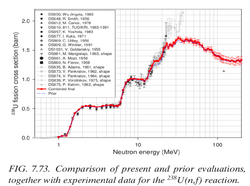 |
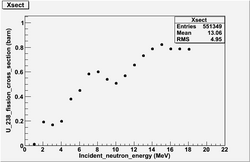 |
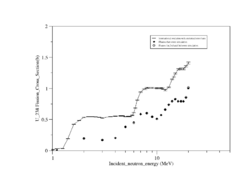
|
4.) Drill holes into the TGEM chamber to mount the HV boards
not done, starts working together as soon as the plates ready.
5.) Simulation Cross Section
New simulation for U-238 under new conditions. but still the simulation is running
I changed the N02SteppingVerbose in a way that can record all fission fragments properties for the 1st, second and third fission reaction for a certain incident neutron energy:
if(NumberOfFissionFragments>0 && fTrack->GetDefinition()->GetAtomicMass()<228 && fTrack->GetDefinition()->GetAtomicMass()>2 && fTrack->GetCurrentStepNumber()==1 && (fTrack->GetParentID()==1 || fTrack->GetParentID()==2 || fTrack->GetParentID()==3))
09/02/10
- RETGEM Preparation
TGEM plate is is prepared as the picture shows below, then covered with resistive paste.
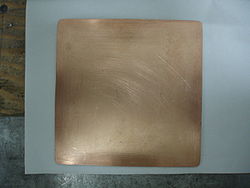 |
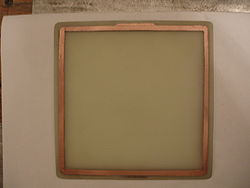 |
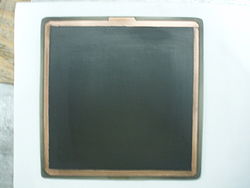
|
- Sparking Test
A single TGEM plate was installed into the ionization chamber and a voltage was applied across the top and bottom of the plate. Sparks were observed when the voltage difference between the top and bottom of the resistive plate reached 2.8 kV. The sparks appeared to be localized to one of the holes. I will take the plate out and try to clean the hole further by filing away resistive paste around the hole. For comparison, the same foil didn't spark until a voltage difference of 7 kV was reached in air. According to Figure 14 in Media:Jinst8_02_p02012_THGEM_spark.pdf , a voltage difference of 1550 Volts was needed in the Double RTGEM configuration to achieve a gain less than 10^4. Our goal is a gain of 10^6 using 3 RTGEM plates. This suggests we should try to reach high voltage differences of at least 2 kV on each plate without sparking.
Sparking test had been done as the detector have air, the highest source voltage recorded was 7 kV. The detector filled with Ar-gas, the highest source voltage detected was 2.8 kV. There is a specific hole that the spark is on, then at around 5 kV it starts to spread around the hole.
An order of needle files will reach tomorrow, another sparking test will be done tomorrow after cleaning the holes and adding more paste.
Do not add more resistive paste yet.
Insert the density of copper and the density of the resistive paste here in the wiki.
09/09/10
- Densities
| Material Name | ED-7100 | Copper |
| Density(g/cm3) | 1.2 g/cm^3 (9.97lbs/gal) | 8.92 g/cm^3 |
- Sparking Test
Sparking test is repeated again after cleaning the hole, cleaning by the new set of files is not effective, the same observation seen again without any improvement from last time.
- Cleaning method
Using the chemicals for cleaning the small holes when the file size is not suitable is suggested by one of the companies.
email from MSCMetalworking.com - Robert <MSCMWtechteam@mscdirect.com> :
e have not heard of anyone making a file that small. Depending on how bad the burr is you might want to try this. Get a .019" DIA pin gage and some lapping compound and see if by spinning the pin in the hole with the compound that it will take care of the burr. Here are the MSC part numbers for the pin and compound. 78372166 [16] 05652581 [17]
- Ionization Simulation
A success in tracking an ionization and resultant electrons from the process is done using N03 edited to have an absorber of Ar-CO2 used mixture:
Region <DefaultRegionForTheWorld> -- appears in <World> world volume
Root logical volume(s) : World
Pointers : G4VUserRegionInformation[0], G4UserLimits[0], G4FastSimulationManager[0], G4UserSteppingAction[0]
Materials : Galactic ArCO2
Production cuts : gamma 1 mm e- 1 mm e+ 1 mm
========= Table of registered couples ==============================
Index : 0 used in the geometry : Yes recalculation needed : No
Material : Galactic
Range cuts : gamma 1 mm e- 1 mm e+ 1 mm
Energy thresholds : gamma 9.9e+02 eV e- 9.9e+02 eV e+ 9.9e+02 eV
Region(s) which use this couple :
DefaultRegionForTheWorld
Index : 1 used in the geometry : Yes recalculation needed : No
Material : ArCO2
Range cuts : gamma 1 mm e- 1 mm e+ 1 mm
Energy thresholds : gamma 9.9e+02 eV e- 9.9e+02 eV e+ 9.9e+02 eV
Region(s) which use this couple :
DefaultRegionForTheWorld
====================================================================
### Run 1 start.
Start Run processing.
---> Begin of event: 0
--------- Ranecu engine status ---------
Initial seed (index) = 0
Current couple of seeds = 814376083, 879723252
----------------------------------------
*********************************************************************************************************
* G4Track Information: Particle = N14[0.0], Track ID = 1, Parent ID = 0
*********************************************************************************************************
Step# X Y Z KineE dEStep StepLeng TrakLeng Volume Process
0 -3 cm 0 fm 0 fm 7 MeV 0 eV 0 fm 0 fm World initStep
1 -2.5 cm 0 fm 0 fm 7 MeV2.73e-15 eV 5 mm 5 mm World Transportation
2 -2.5 cm 0 fm 0 fm 6.96 MeV 39.8 keV 14.9 um 5.01 mm ArCO2 ionIoni
3 -2.5 cm -2.46 Ang-5.07e+04 fm 6.92 MeV 33.2 keV 14.7 um 5.03 mm ArCO2 ionIoni
4 -2.5 cm -2.87 Ang-5.84e+04 fm 6.92 MeV 5.5 keV 4.47 um 5.03 mm ArCO2 ionIoni
5 -2.5 cm -2.88 Ang-5.93e+04 fm 6.92 MeV 73.7 eV 43.2 nm 5.03 mm ArCO2 ionIoni
6 -2.49 cm -7.11 Ang -9.68 Ang 6.85 MeV 69.8 keV 23.1 um 5.06 mm ArCO2 ionIoni
7 -2.49 cm -7.16 Ang -1.06 nm 6.84 MeV 6.9 keV 2.9 um 5.06 mm ArCO2 ionIoni
8 -2.49 cm -1.19 nm -1.73 nm 6.78 MeV 58.9 keV 22.2 um 5.08 mm ArCO2 ionIoni
9 -2.49 cm -1.38 nm -2.58 nm 6.73 MeV 47.2 keV 20.5 um 5.1 mm ArCO2 ionIoni
10 -2.49 cm -1.82 nm -5.11 nm 6.66 MeV 69.5 keV 42.2 um 5.15 mm ArCO2 ionIoni
11 -2.48 cm -2.09 nm -5.86 nm 6.63 MeV 31.2 keV 16.2 um 5.16 mm ArCO2 ionIoni
12 -2.48 cm -2.41 nm -6.52 nm 6.6 MeV 25.1 keV 13.4 um 5.17 mm ArCO2 ionIoni
13 -2.48 cm -2.87 nm -8.21 nm 6.52 MeV 84.5 keV 40.2 um 5.21 mm ArCO2 ionIoni
14 -2.47 cm -3.24 nm -12.3 nm 6.32 MeV 195 keV 78.5 um 5.29 mm ArCO2 ionIoni
15 -2.43 cm -5.06 nm -32.1 nm 5.55 MeV 769 keV 382 um 5.68 mm ArCO2 ionIoni
16 -2.4 cm -6.78 nm -50.7 nm 4.67 MeV 886 keV 360 um 6.04 mm ArCO2 ionIoni
17 -2.36 cm -8.38 nm -68.2 nm 3.82 MeV 845 keV 337 um 6.37 mm ArCO2 ionIoni
18 -2.33 cm -9.89 nm -84.6 nm 3.02 MeV 797 keV 317 um 6.69 mm ArCO2 ionIoni
19 -2.3 cm -11.3 nm -100 nm 2.25 MeV 773 keV 299 um 6.99 mm ArCO2 ionIoni
20 -2.27 cm -12.7 nm -115 nm 1.55 MeV 703 keV 285 um 7.27 mm ArCO2 ionIoni
21 -2.25 cm -14 nm -129 nm 1.03 MeV 513 keV 272 um 7.54 mm ArCO2 ionIoni
22 -2.22 cm -15.2 nm -143 nm 619 keV 415 keV 262 um 7.81 mm ArCO2 ionIoni
23 -2.19 cm -16.4 nm -155 nm 349 keV 270 keV 250 um 8.06 mm ArCO2 ionIoni
24 -2.17 cm -17.5 nm -168 nm 117 keV 232 keV 235 um 8.29 mm ArCO2 ionIoni
25 -2.15 cm -18.5 nm -178 nm 0 eV 117 keV 193 um 8.48 mm ArCO2 ionIoni
*********************************************************************************************************
* G4Track Information: Particle = e-, Track ID = 13, Parent ID = 1
*********************************************************************************************************
Step# X Y Z KineE dEStep StepLeng TrakLeng Volume Process
0 -2.48 cm -2.87 nm -8.21 nm 998 eV 0 eV 0 fm 0 fm ArCO2 initStep
1 -2.48 cm -1.27 um 1.81 um 0 eV 998 eV 57.4 um 57.4 um ArCO2 eIoni
*********************************************************************************************************
* G4Track Information: Particle = e-, Track ID = 12, Parent ID = 1
*********************************************************************************************************
Step# X Y Z KineE dEStep StepLeng TrakLeng Volume Process
0 -2.48 cm -2.41 nm -6.52 nm 1 keV 0 eV 0 fm 0 fm ArCO2 initStep
1 -2.48 cm -2.23 um -1.32 um 0 eV 1 keV 57.8 um 57.8 um ArCO2 eIoni
*********************************************************************************************************
* G4Track Information: Particle = e-, Track ID = 11, Parent ID = 1
*********************************************************************************************************
Step# X Y Z KineE dEStep StepLeng TrakLeng Volume Process
0 -2.48 cm -2.09 nm -5.86 nm 1.03 keV 0 eV 0 fm 0 fm ArCO2 initStep
1 -2.48 cm 1.19 um 568 nm 0 eV 1.03 keV 59.8 um 59.8 um ArCO2 eIoni
*********************************************************************************************************
* G4Track Information: Particle = e-, Track ID = 10, Parent ID = 1
*********************************************************************************************************
Step# X Y Z KineE dEStep StepLeng TrakLeng Volume Process
0 -2.49 cm -1.82 nm -5.11 nm 1 keV 0 eV 0 fm 0 fm ArCO2 initStep
1 -2.48 cm 1.31 um -2.62 um 0 eV 1 keV 57.7 um 57.7 um ArCO2 eIoni
*********************************************************************************************************
* G4Track Information: Particle = e-, Track ID = 9, Parent ID = 1
*********************************************************************************************************
Step# X Y Z KineE dEStep StepLeng TrakLeng Volume Process
0 -2.49 cm -1.38 nm -2.58 nm 993 eV 0 eV 0 fm 0 fm ArCO2 initStep
1 -2.49 cm 224 nm 3.5 um 0 eV 993 eV 57 um 57 um ArCO2 eIoni
*********************************************************************************************************
* G4Track Information: Particle = e-, Track ID = 8, Parent ID = 1
*********************************************************************************************************
Step# X Y Z KineE dEStep StepLeng TrakLeng Volume Process
0 -2.49 cm -1.19 nm -1.73 nm 1.01 keV 0 eV 0 fm 0 fm ArCO2 initStep
1 -2.49 cm -2.39 um 2.17 um 0 eV 1.01 keV 58.5 um 58.5 um ArCO2 eIoni
*********************************************************************************************************
* G4Track Information: Particle = e-, Track ID = 7, Parent ID = 1
*********************************************************************************************************
Step# X Y Z KineE dEStep StepLeng TrakLeng Volume Process
0 -2.49 cm -7.16 Ang -1.06 nm 999 eV 0 eV 0 fm 0 fm ArCO2 initStep
1 -2.49 cm 3.77 um -385 nm 0 eV 999 eV 57.5 um 57.5 um ArCO2 eIoni
*********************************************************************************************************
* G4Track Information: Particle = e-, Track ID = 6, Parent ID = 1
*********************************************************************************************************
Step# X Y Z KineE dEStep StepLeng TrakLeng Volume Process
0 -2.49 cm -7.11 Ang -9.68 Ang 1.01 keV 0 eV 0 fm 0 fm ArCO2 initStep
1 -2.49 cm 4.91 um -7.92 um 658 eV 356 eV 19.7 um 19.7 um ArCO2 msc
2 -2.49 cm 12.8 um -6.9 um 0 eV 658 eV 34.6 um 54.3 um ArCO2 eIoni
*********************************************************************************************************
* G4Track Information: Particle = e-, Track ID = 5, Parent ID = 1
*********************************************************************************************************
Step# X Y Z KineE dEStep StepLeng TrakLeng Volume Process
0 -2.5 cm -2.88 Ang-5.93e+04 fm 1.03 keV 0 eV 0 fm 0 fm ArCO2 initStep
1 -2.5 cm -9.66 um -402 nm 834 eV 193 eV 19.8 um 19.8 um ArCO2 msc
2 -2.5 cm -9.32 um 10 um 584 eV 250 eV 19.8 um 39.7 um ArCO2 msc
3 -2.5 cm -6.96 um 7.34 um 0 eV 584 eV 19.8 um 59.5 um ArCO2 msc
*********************************************************************************************************
* G4Track Information: Particle = e-, Track ID = 4, Parent ID = 1
*********************************************************************************************************
Step# X Y Z KineE dEStep StepLeng TrakLeng Volume Process
0 -2.5 cm -2.87 Ang-5.84e+04 fm 992 eV 0 eV 0 fm 0 fm ArCO2 initStep
1 -2.5 cm 11.2 um 4.42 um 992 eV 0 eV 19.5 um 19.5 um ArCO2 msc
2 -2.5 cm 24.4 um 9.57 um 965 eV 26.6 eV 19.5 um 38.9 um ArCO2 msc
3 -2.5 cm 28.7 um 5.64 um 846 eV 119 eV 19.5 um 58.4 um ArCO2 msc
4 -2.5 cm 34.4 um 2.56 um 436 eV 410 eV 19.5 um 77.8 um ArCO2 msc
5 -2.5 cm 35.8 um -153 nm 5.97 eV 430 eV 19.5 um 97.3 um ArCO2 msc
6 -2.5 cm 36.2 um -774 nm 0 eV 5.97 eV 2.26 um 99.5 um ArCO2 eIoni
*********************************************************************************************************
* G4Track Information: Particle = e-, Track ID = 3, Parent ID = 1
*********************************************************************************************************
Step# X Y Z KineE dEStep StepLeng TrakLeng Volume Process
0 -2.5 cm -2.46 Ang-5.07e+04 fm 1.08 keV 0 eV 0 fm 0 fm ArCO2 initStep
1 -2.5 cm -8.67 um 7.15 um 630 eV 445 eV 20.5 um 20.5 um ArCO2 msc
2 -2.5 cm -9.31 um 11.5 um 0 eV 630 eV 20.5 um 41.1 um ArCO2 msc
*********************************************************************************************************
* G4Track Information: Particle = e-, Track ID = 2, Parent ID = 1
*********************************************************************************************************
Step# X Y Z KineE dEStep StepLeng TrakLeng Volume Process
0 -2.5 cm 0 fm 0 fm 1.04 keV 0 eV 0 fm 0 fm ArCO2 initStep
1 -2.5 cm 2.01 um 10.8 um 1.02 keV 14.4 eV 20 um 20 um ArCO2 msc
2 -2.5 cm -9.15 um 16.7 um 760 eV 262 eV 20 um 40 um ArCO2 msc
3 -2.5 cm -22.9 um 18.9 um 380 eV 380 eV 20 um 60 um ArCO2 msc
4 -2.5 cm -25.3 um 15.8 um 0 eV 380 eV 20 um 79.9 um ArCO2 msc
---> End of event: 0
Absorber: total energy: 7 MeV total track length: 4.2 mm
Gap: total energy: 0 eV total track length: 0 fm
Run terminated.
Run Summary
Number of events processed : 1
User=0s Real=0.16s Sys=0.01s
--------------------End of Run------------------------------
mean Energy in Absorber : 7 MeV +- 0 eV
mean Energy in Gap : 0 eV +- 0 eV
mean trackLength in Absorber : 4.2 mm +- 6.5e+03 fm
mean trackLength in Gap : 0 fm +- 0 fm
Notes:
- It is not clear yet if there are other particles produced through the ion track. "G4ionIonisation" is the only process used.
- The absorber thickness will determine the ion maximum energy and the number of tracked electrons. so the fission fragments won't all share in the ionization but the ones have the appropriate energy (and mass).
09/14/10
defaultCutValue
Set defaultCutValue=1.0*mm in example N02 to see if you can get ionized electron tracking.
- U-fx-section Simulation
The figures show the U-fxsection in case of counting the fragments from 1st fission reaction only and counting the fragments from fission reactions that follow the the 1st one.
| 1st_2nd_3rd Fission | 1st_Fission |
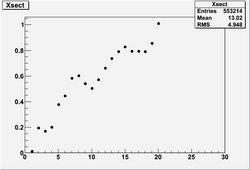 |

|
Notes: the first figure shows an increase in the value of f-xsection when the incident neutron energy is 10 MeV or more, also the f-xsection is increasing when the energy is 20 MeV. So the first figure is closer to the experimental fission cross given by ENDF [[18]].
Overlay the above results onto the ENDF plot.
- TGEM Detector Plates
10X10 holes 0.5mm diameter and 1.3mm center to center distance are going to be ready tomorrow. Sparking test results are going to be ready by the next meeting.
10/18/10
Haithem's daily log report: oles are dre
10/19/10
- New TGEM (HTTGEM_1)
Three HTTGEM_1 foils were manufactured and tested up to 3 kV in air. The same foils would hold 2.2-2.3 kV when immersed ina 90/10 ArCO2 gas mixture.
- The design of HTTGEM_1
Each HTGEM_1 is constructed using 0.5 mm thick copper clad FR4 plate that are 12 x 12 cm in size. The copper layer is 17 um thick. The copper is etched until a 2 mm thick border remains around the plate which will be used to apply a voltage between the top and bottom of the plate. The exposes FR4 is coated with the resistive paste ED-7100. Holes of diameter 0.5 mm (0.02") are drilled in a pattern as in the figure below. A rim of width 0.15 mm is made around each hole to separate the hole from surrounding resistive paste. The hole pitch is 0.8 mm.
10/20/10
No reported work done (please look at the experiment timetable) [19]
10/21/10
No reported work done (please look at the experiment timetable) [20]
10/22/10
No reported work done (please look at the experiment timetable) [21]
10/24/10
- HTTHGEM sparking test
Previously mentioned that HTTHGEM foil individually passed the sparking test up to 3 kV in air, as soon as they are connected by the HV-circuit, the electric field produced by each foil has an effect on the other foil, the effect appears as sparking. Two of HTTHGEM were recently tested in air when a separation distance was 9mm, sparking around the holes started when the source voltage was about 5 kV (about 1.3 kV on each foil).
10/27/10
- Sparking test for two-HTTHGEM in air
Two HTTHGEM foils placed in TGEM chamber, they were shorted to HV-power supply simultaneously, the foils passed the sparking test in air up to 3 kV with a separation distance between them of magnitude of 2 mm. The foils were shorted according to the table (the bottom foil placed in the chamber is HTTHGEM_1) :
| bottom | top | |
| HTTHGEM_1 voltage | high | low |
| HTTHGEM_2 voltage | low | high |
If I understand the above configuration, then I would not expect electrons to pass through HTTHGEM 1 and head towards HTTHGEM 2. It would minimize sparking because there would be no potential difference between the top of HTTHGEM2 and the bottom of HTTHGEM1. Please construct the configuration I requested; a HV connector on each THGEM card. The next configuration will be to create a potential difference (100 Volts) between the bottom of HTTHGEM 1 and the top of HTTHGEM 2.
- Sparking test for two-HTTHGEM in Ar/CO2
| Distance between the foils (mm) | maximum voltage before spaking (kV) | notes |
| 2 | 1 | more than 1 kV sparking started from the edges then the holes |
| 5 | not complete, the foils start to spark as the voltage is 1 kV, they should be cleaned |
- Original HV-circuit [22]
The link is for the original HV-circuit, there is a capacitor connected before the wire goes to the bottom of the first THGEM, I wonder if this capacitor is a job related to collecting charge. I will try to connect one before the wire goes to HTTHGEM to check if it will give any changes.
10/28/10
- Beak board
The new break board is ready for use.
10/29/10
- Sparking Test for two HTTHGEM in air
Two of HTTHGEM have been shorted to two different power supply as represented in the table:
| bottom | top | |
| HTTHGEM_1 voltage | ground | high |
| HTTHGEM_2 voltage | ground | high |
The results are summarized by the table
| HTTHGEM_1 | HTTHGEM_2 | observation | |
| voltage (kV) | 1 | 1 | no sparking |
| voltage (kV) | 1.5 | 2 | sparking and burning, HTTHGEM_2 was on 2 kV, gradually HTTHGEM_2 voltage increased until 1.5 kV |
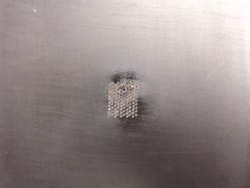 |
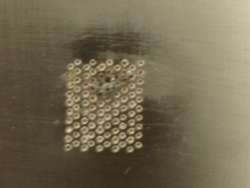
|
Cleaning and reapplied the paste on the damaged foil to repeat the experiment under Ar/CO2.
10/30/10
The above damage is impressive. Why are sparks absent when the card is at 2 kV and alone but there is sparking if it is within a second card. What was the separation distance between the to cards when the sparking happened.
For the above table results the separation distance is 5 cm.
- Reasons for sparking
- Current loops in the HTTHGEM foil.
- This situation reminds me a lot with mutual inductance, but instead of the magnetic field, it is for electric field, since the current existance is an evidence for a change (only electric field lines here), as I am changing the voltage, electric field lines density changes, a force is produced inside the HTTHGEM_2 to resists the change, but what is really impressive if this is right, the damage should in the foil where the forced is produced not the other foil!!
-A nice paper talking about detector failure is File:High rate behavior and discharge limits in micro-pattern detectors .pdf, in the reference's page 322 first paragraph is describing a situation similar to ours, in the first sentence in the paragraph is saying: "The presence of a high field on the cathode edges limits the maximum voltage that can be reached in MSGCs"(micro strip gas chamber). but he is not saying why. Also i do not feel that I understand when he starts talking about proportional avalanche and streamer and their relationship with ionizing tracks at high operating voltage in the absence of the radiation field ?!
11/1/10
Insulators under a high voltage
11/2/10 (Insulators under a high voltage)
Insulators under a high voltage
- Six samples of FR4 are cut, each has 2.2X2.2 mm. There are going to be weighted by micro gram scale. The experiment (measuring the paste thickness) is going to be repeated again.
11/3/10
- Experimenting Sparking test for HTTHGEM
-Aim: Studying the effect of the voltage and the separation distance on operating HT-THGEM up to 2kV using HT-THGEM foil and a Cathode foil.
-Experimental set up : Connecting the each side of the HT-THGEM with a power supply and the cathode foil with a third power supply.
-Experimental results
| Separation distance (mm) | type of gas surrounding | V1 (top HT-THGEM) voltage (V) | V2 (bottom HT-THGEM) voltage(V) | Cathode Voltage (V) | Notes |
| 3.5 | air | 0 | 4404 | 2025 | sparking at the edge |
| 3.5 | air | 7514 | 4017 | 2025 | parking at the edge and in the holes |
| 3.5 | Ar/CO2 (debugging) | 6014 | 4014 | 2024 | Sparking everywhere |
-Conclusion and next action: Sparking appears for many reasons as poor insulation for the wire, oe sharp edges in the foils.
so, trying to exclude all the other effects by improving the wire insulation, and cover the sharp edges.
- SEM analysis
The prepared samples were covered with paste in different thickness, there are going to be weighted again after applying the paste by microgram scale.
11/4/10
- Sparking Test
| Separation distance (mm) | type of gas surrounding | V1 (top HT-THGEM) voltage (V) | V2 (bottom HT-THGEM) voltage(V) | Cathode Voltage (V) | Notes |
| 1.0 | Ar/CO2 (debugging) | 1061 | 1062 | 2931 | sparking at the edge |
| 2.5 | Ar/CO2 (debugging) | 1061 | 1062 | 4390 | sparking at the edge |
| 3.0 | Ar/CO2 (debugging) | 1061 | 1062 | 5391 | sparking at the edge, shows the clearly the error in measuring the distance may forbid to have accurate voltage measurements when the distance changes by 0.5 mm only |
| 3.5 | Ar/CO2 (debugging) | 1061 | 1062 | 5570 | sparking at the edge |
| 5 | Ar/CO2 (debugging) | 1061 | 1062 | 6755 | sparking at the edge |
| 6.5 | Ar/CO2 (debugging) | 1061 | 1062 | 7100 | sparking at the edge |
The distance between the plates has a certain error, since the screws' are almost without threads, they have to be replaced by new screws for more accurate distance measurements.
I used the vernier caliber, and I found each nut gives a separate distance 3.5 mm, each washer gives a 1.5 mm. the only way to have 2.0 mm is to have good threads to hold the nuts.
11/08/10
- Sparking Test
The same experiment set up (done by 11/04/10) is tested but under Ar/CO2 close chamber, the voltage of the cathode was 3174 V without any sparking inside the chamber. So debugging is giving close results as close as the gas chamber is close.
The table represents the results of 2 HT-THEM shorted in the same way as the experiment done before to measure the maximum voltage applied before sparking within a certain gap length.
| Separation distance (mm) | type of gas surrounding | V2GT (V) | V2GB (V) | V1GT(V) | Notes |
| 1.0 | Ar/CO2 (debugging) | 1061 | 1062 | 3493 | sparking at the edge |
| 2.5 | Ar/CO2 (debugging) | 1061 | 1062 | 5439 | sparking at the edge,should be repeated tomorrow |
| 3.0 | Ar/CO2 (debugging) | 1061 | 1062 | 4838 | sparking at the edge |
where:
V1GB = bottom of the first THGEM card which is placed 2 mm above the charge collector
V1GT = top of the first THGEM card
V2GB = bottom of second THGEM card just above the first TGEM card.
V2GT = top of second THGEM card.
11/09/10
- Sparking Test
The sparking test was repeated for he HT-THGEM foils as the top foil has 2 kV on both sides.
| Separation distance (mm) | type of gas surrounding | V2GT (V) | V2GB(V) | V1GT (V) | Notes |
| 6.5 | Ar/CO2 (debugging) | 2018 | 2000 | 7609 | sparking at the edge |
| 5.0 | Ar/CO2 (debugging) | 2018 | 2000 | 6354 | sparking at the edge and holes |
| 3.5 | Ar/CO2 (debugging) | 2018 | 2000 | 5335 | sparking at the edge |
| 2.5 | Ar/CO2 (debugging) | 2018 | 2000 | 4866 | sparking at the edge |
where:
V1GB = bottom of the first THGEM card which is placed 2 mm above the charge collector
V1GT = top of the first THGEM card
V2GB = bottom of second THGEM card just above the first TGEM card.
V2GT = top of second THGEM card.
Shorting HT-THGEM to a power supply(s) to get the operating voltage with the least parking under Ar/CO2 gas mixture was he aim of previous experiment, the test started by a setup consists of a cathode plate and HT-THGEM plate. The result showed that applying a voltage to the top of cathode plate is possible up to 2931V when the HT-THGEM plate has 1000 V applied on both sides with a separation distance of 2.5 mm.
Under the same conditions the second part of the test took place but by replacing the cathode by a second HT-THGEM. With 1000 V applied on both sides of the top HT-THGEM and separation distance of 2.5 mm from the first plate, The maximum applied voltage to the top of first plate was 3493V.
Finally, repeating the second part of the test with the same separation distance but increasing the voltage of the second HT-THGEM up to 2000V, the result gave 4838 V is the higest on the top of the first HT-THGEM plate.
| setup | cathode/HT-THGEM (1kV) | HT-THGEM /HT-THGEM (1kV) | HT-THGEM /HT-THGEM (2kV) |
| V1GT (V) | 2931 | 3493 | 4838 |
| Difference in voltage V1GT-V2GB (V) | 1931 | 2431 | 2838 |
There is 407 V difference between the last two results for 2 HT-THGEM I wonder why??(hopefully it is just underestimating the voltage).
- Next
- Testing the last part again when the chamber is close and has Ar/C02 with the same distance and V1GT = 4kV.
- Machining two more HT-GEM for more test as the three of them together.
11/12/10
- New HT_THGEM
Another 2 foils of HT-THGEM are going to be machined by the next week.
- Warrent logbook
I do not understand when Warren wrote :
- The code in GEMReadout.vhd governs the behavior of the GEMReadout component.
- Code governing the G0 (Gin(0)) and G1 (Gin(1)) Inputs
- In GEMReadout.vhd the signal GIN(1) gets loaded into HARD_TRIGGER. HARD_TRIGGER then gets loaded into the HARD_TRIGGER of the GEMTrigger component as well as the HARD_TRIGGER of a GEMTxChannel component. Thus far I am unclear what is done with this HARD_TRIGGER signal for these components. I will figure this out on Friday, hopefully.
- Still in GEMReadout.vhd the GIN(0) signal gets loaded into the inclk0 value of the PLLBlock component. In PLLBlock.vhd (which governs the behavior of the PLLBlock component), this c0 signal eventually ends up being connected to clk(0) for the altpll component. The altpll component appears to be a predefined cell in Quartus II. I hypothesize that this component is just a pll with user-defined settings. Hopefully on Friday I can find some documentation on this component to figure out exactly how it works. Thus in GEMReadout.vhd we put in our original signal G0 and get out a locked version on PLLCLK.
- This appears to be in GEMReadout.vhd where the process trigger PLLCLK is generated. All other components that take this value in on one of its ports has it as an input rather than an output.
- Allied connectors
I got the connectors we ordered from Allied Electronics.
11/15/10
| Gap1(mm) | V1GB (kV) | V1GT(kV) | GAP2(mm) | V2GB(kV) | V1GT(kV) | Notes |
| 3 | 2 | 2 | 5 | 6.26 | sparking from the edge fom the foil, still I can not say if starts from top to bottom or in opposite | |
| 3 | 2 | 2 | 2.5 | 5.77 | ||
| 3 | 1 | 2 | 5 | 6.3 | sparking from the edge fom the foil, still I can not say if starts from top to bottom or in opposite | |
| 3 | 1 | 2 | 2.5 | 5.78 |
11/17/10
- Connectors
One of the new 130 pins connected is soldered on its PC-board.(need to check if I should do the rest of them), also 8 of connectors are removed (unsoldered) from the GEM detector.
- GEANT4 Workshop
GEANT4 tutorials workshop is going to be in Texas AM University in January 10-14-2011. [23]
12/1/10 (gas piping)
- Flex pipes and connectors
12/6/10
Insulators under a high voltage
- Gas discharge failure solutions
Using N2 pr SF6 mixed with a cetain percentage with AR/CO2 gas.
- Connectors
20 pins 1.27 mm pitch . http://www.westfield.co.uk/tp/html/15.html.



